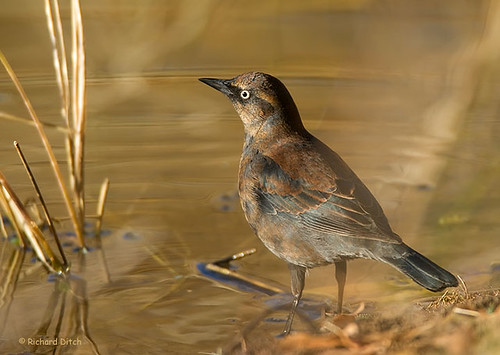tags: Rusty Blackbird, Euphagus carolinensis, birds, mystery bird, bird ID quiz
[Mystery bird] Rusty Blackbird, Euphagus carolinensis, photographed in Arizona. [I will identify this bird for you tomorrow]
Image: Richard Ditch, 2006 [larger view].
Please name at least one field mark that supports your identification.
Rick Wright, Managing Director of WINGS Birding Tours Worldwide, writes:
Stout-footed, stout-billed, and terrestrial: any surprise that our mystery bird is an icterid? Its modest tail rules out the grackles, the yellow eye and pointed bill the cowbirds, the lack of streaking beneath female-plumaged Red-winged and Yellow-headed Blackbirds. What remains is the Euphagus blackbirds, medium-sized, slender icterids with uniformly dark plumage and (at least in some age- and sex-classes) glowing yellow eyes.
Female Brewer's Blackbirds have liquid brown eyes, so we are faced here with either a Rusty Blackbird or a male Brewer's Blackbird. The warm brown body, broad buffy supercilium, and black lore suggest Rusty. The bill, in this view, appears heavy and broad-based for that species, but it is sharply pointed and the culmen is straight; on Brewer's Blackbird, the culmen is gently curved downward and the bill tip slightly arched. And even the brownest Brewer's Blackbird should show plain wings, without the rusty edgings so conspicuous here.
Rusty Blackbird was a familiar visitor to my Midwestern birding childhood, flocks of them arriving every October, a few lingering in wet bottomlands for the winter, then great creaking hordes passing through again in spring. But recent years have seen the virtual disappearance of this once abundant species, and sightings are being carefully tracked. The reasons for this decline remain unclear, but habitat loss, global warming, and pesticide use on the wintering grounds are all likely part of it.


I'm calling that an adult male Rusty Blackbird in non-breeding plumage.
Size, shape, and beak show it clearly to be an icterid; the bird's plumage coloring and eye color eliminate most of the other possibilities. Having narrowed things down, I note the "pale-edged tertials" mentioned by Sibley (hooray for specific plumage topography!), which this photo shows really well.
I know I'm almost certainly wrong, but I'd swear it was a young starling coming into adult plumage from juvenile. They lose the brown on the wings and get their adult brown-edged black primary feathers while the back and head are still the juvie brown.
Well, the field marks all point to Rusty Blackbird: yellow eye, rusty edges to wing-coverts, facial pattern, overall proportions, lack of iridescence... but the location given is all wrong, that's far outside this species range.
Either "photographed in Arizona" is in error, or we have here a photo of a rare event.
Yep, it's in Arizona. We get quite a few easterners out here.
Yes, this was photographed in AZ, where it is a rarity. Taken at the Rio Salado habitat restoration area at the Salt River bed just south of downtown Phoenix.